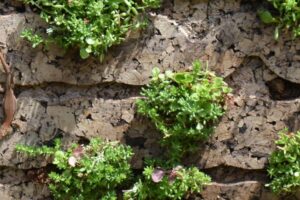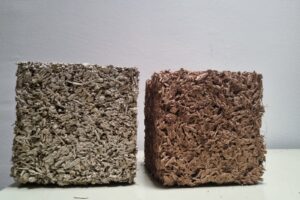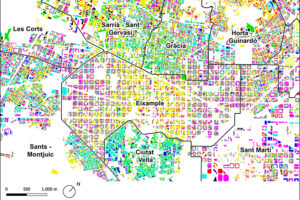
Race Walk Chip: a chip developed by the UPC to transform race walking
July 14, 2025
HYDROHEAL: Improving Bone Fracture Treatment with Advanced Biomaterials
July 24, 202522/07/2025
A multidisciplinary team of researchers from the Research Group in Smart and Sustainable Resources and Industries (RIIS), the Sustainable Mining Research Group (GREMS), and the Construction Materials and Roads (MATCAR) group at the Universitat Politècnica de Catalunya – BarcelonaTech (UPC) is leading the VALORFIN project. The aim is to develop a technological solution for the valorisation of the fine fraction of construction and demolition waste (CDW), transforming it into new low-CO₂-emission cementitious materials, while also reducing the presence of hazardous materials in this waste.
The transition to a circular economy is essential to reduce the environmental impact of the construction sector, which is responsible for a large volume of waste and around 8% of global CO₂ emissions, mainly due to Portland cement production. Valorising the fine fraction of CDW, which has been underused until now, presents a promising solution for reducing emissions and making use of existing resources.
Currently, CDW recycling focuses primarily on the coarse fraction, i.e. the larger-sized materials. However, the fine fraction mainly consists of cement paste, which contains amorphous calcium silicate hydrates and calcium aluminate hydrates, calcium hydroxide, along with the finer portions of aggregates, brick debris, gypsum, and soil. From these components, it is possible to manufacture binder materials that can partially replace Portland cement. This leads to energy and raw material savings and a considerable reduction in CO₂ emissions.
The VALORFIN project aims to develop a technological solution to reuse this fine fraction of CDW in the production of a new reactive material suitable for manufacturing low-emission blended cements.
To achieve this, experiments will be carried out using waste collected directly from demolition plants, employing binders to precipitate fine components from washing waters. Physical separation methods that do not require chemical agents will also be tested.
Using these fine fractions, the properties of industrial residues will be modified to transform them into Supplementary Cementitious Materials (SCMs), suitable for use in low-carbon blended cements. Additives will be used to adjust formulations, and slag and kaolinitic materials will be incorporated to enhance the properties of the new products.
The main expected outcomes of the project include:
- Obtaining and characterising secondary raw materials: construction and demolition waste mixed with slags or kaolin.
- Optimisation of separation and activation processes.
- Formulating waste combinations and optimising thermal and mechanical activation processes to produce active materials with binding properties.
- Studying the behaviour of pastes and mortars with blended binders in both fresh and hardened states.
- Assessing the potential release of contaminants from the final materials and conducting life cycle analysis.
Impact
The VALORFIN project could have a significant environmental impact. With a 30% replacement of Portland cement, up to 451,000 tonnes of CO₂ could be avoided annually, effectively contributing to climate change mitigation. In more ambitious scenarios, with replacement levels up to 76%, emission reductions could exceed 1.1 million tonnes of CO₂ per year. In addition to reducing pressure on natural resources such as limestone, this would help meet the construction sector’s decarbonisation and circular economy targets.
The project is also aligned with the “Climate change adaptation, including societal transformation” objective under the European Commission’s Horizon Europe programme, within the framework of the EU Missions.
Budget and Funding
The project is part of the Spanish national Plan for Scientific and Technical Research and Innovation 2021–2023 (PID2022-1415140B-I00), funded with a budget of € 87,500. It will run for four years (September 2023 – August 2027).


Sector
Topic
You want to know more?
Related Projects
- The La Volta project foresees the construction of a large Catalan vault pergola within the Llars Mundet campus, in the Montbau neighbourhood (Horta-Guinardó district). This structure will become a new architectural landmark for Barcelona, combining traditional construction techniques with contemporary innovation. The project involves the Rehabilitation and Architectural Restoration Research Group (REARQ), at the Universitat Politècnica de Catalunya - BarcelonaTech (UPC), and is led by the Architects’ Association of Catalonia (COAC) and the Barcelona Provincial Council.
SATE-VEG: A system for energy renovation of buildings that helps reduce the urban heat island effect
Researchers from the Architecture, Energy and Environment (AiEM) group at the Universitat Politècnica de Catalunya - BarcelonaTech (UPC) have developed SATE-VEG, an external thermal insulation system with a vegetal coating that offers seasonally adaptive thermal behaviour, enhances urban biodiversity and promotes positive health effects. The system is made from organic materials, requires low maintenance and consumes minimal water.- A research team from the Interdisciplinary Group on Building Science and Technology (GICITED) at the Universitat Politècnica de Catalunya – BarcelonaTech (UPC) is leading the BioSAFE project, which aims to develop sustainable building envelopes —mainly façades— designed according to sustainability, comfort and safety criteria, with particular attention to their acoustic behaviour and fire performance.
- The Architecture, Energy and Environment (AiEM) research group at the Universitat Politècnica de Catalunya - BarcelonaTech (UPC) has characterised Barcelona’s residential buildings according to their capacity to adapt to climate change. This study is part of the project ‘VeUvE: Urban havens for vulnerable zones’. The work highlights the climate inequality conditions present across different areas of the city and will help to better define the priorities and energy renovation strategies for its districts.




